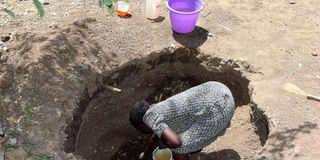Breaking News: At least 10 feared to have drowned in Makueni river
Horn of Africa reeling under grip of drought

This photograph dated January 17, 2017 shows a woman fetching water from a hole she had dug on the dry riverbed of River Nyaidho in Awasi, Kisumu. PHOTO | TONNY OMONDI | NATION MEDIA GROUP
What you need to know:
- Some of initiatives are derailed by budgetary constraints, long and protracted procurement, conflicts in disaster-prone areas and controversies over their environmental and social impact.
- Others can be achieved fairly quickly.
- Strategic and timely action will significantly reduce the impact of drought and liberate people from perpetual dependency on handouts.
The drought in the Horn of Africa has caused a severe food crisis that threatens the lives of 17 million people in Ethiopia, Kenya, Somalia, South Sudan and Uganda. The humanitarian disaster is unprecedented in scale and impact, and could spread further in the next few months. The number of people living on the edge is nearly twice the 9.5 million who suffered from the harsh 2011 drought emergency in the region. Humanitarian aid agencies have stepped up appeals for food, drugs and nutrients to suppress the impact of the crisis, particularly on pregnant and lactating mothers and children, who are at the highest risk of suffering irreversible consequences from malnutrition.
At the peak of the last drought, which was described as the worst in 60 years, the humanitarian community rapidly responded, though some of the relief was too little too late to reverse the destiny of starving people and livestock. This time, relief is just trickling in, even as the crisis intensifies due to a sharp increase in staple food prices and deadly conflict over water and pasture. President Uhuru Kenyatta declared the drought a national disaster, scaling up the government’s emergency allocations for the most needy communities, but budgetary constraints, particularly in an election year, have hampered the government’s ability to respond in time, scale and quality without adequate support from development partners and aid agencies.
FIELD ASSESSMENTS
The cyclical nature of the drought has been well-documented through decades of field assessments by affected governments, researchers and development agencies. The cycle is predictable — coming every four to five years.
An assessment carried out by the countries affected by the 2011 drought, with support from the United Nations, World Bank and European Union, detailed the impact of drought on the communities and economies. It also quantified the type and scale of investment needed to strengthen the long-term resilience of the communities. A Post-Disaster Needs Assessment of the 2008-2011 drought estimated Kenya’s losses from drought at $12.1 billion (then equivalent to Sh968.6 billion). This included lost flows to economic sectors and destruction of physical and durable assets. The report said the government needed to invest $3.9 billion (Sh341 billion then) in recovery, reconstruction and additional disaster risk reduction programmes to break the cycle of drought. The International Federation of the Red Cross advocates change in policy from emergency responses to more long-term interventions that will make communities more resilient to drought and other natural disasters. That the crisis has spread so fast in the past few months is an indictment of the failure of policy and implementation. Aid agencies estimate they will need over $ 2 billion to support the hungry and help mitigate livestock losses. These people need food, nutritional supplements, and post-drought recovery interventions. The action is critical for the emergency, but it shouldn’t overshadow the fact that the ultimate solution lies in investing in long-term priority programmes in agriculture, livestock, water and irrigation, energy, health, education, social protection and climate mitigation.
BUDGETARY CONSTRAINTS
Some of the initiatives, such as construction of large dams that check flooding during heavy rains and store water for use in the dry seasons, are derailed by budgetary constraints, long and protracted procurement, conflicts in disaster-prone areas and controversies over their environmental and social impact. Others such as rehabilitation of dams, water pans and boreholes, can be achieved fairly quickly. Strategic and timely action will significantly reduce the impact of drought and liberate people from perpetual dependency on handouts.
Peter Warutere is principal partner, M.A. Consulting Group.




